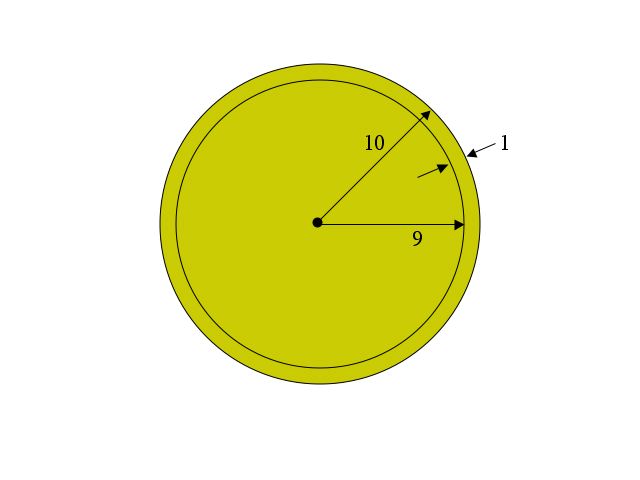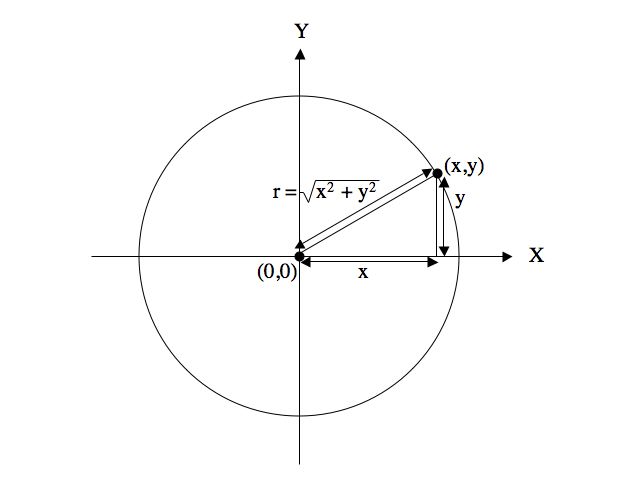
Spheres in High Dimensions, Part 3
This continues the discussion of hyperspheres (spheres in more than three dimensions) summarized in the figure below. If you have somehow navigated here without first going through the earlier sections, this figure and the following discussion will be meaningless and you need to go to Part 1 for a statement of the problem and a link to Part 2, before going any further here.

When I used this problem on the Ph.D. qualifying exam, many students got stuck either wondering how to describe a 100-dimensional sphere or trying to find the formula for the volume of a sphere in 100 dimensions. If they got stuck in either of those quagmires, I needed to step in and help them with the idea of first considering the problem in 3 dimensions.
With their more extensive math backgrounds, they could have come up with the description of a high dimensional sphere in a few minutes. Some even figured that out and wrote it down immediately after I finished stating the problem. But, as we saw in the earlier parts of this discussion, the equation for a high dimensional sphere was not needed and would only have been a distraction.
As for trying to find the formula for the volume of a 100-dimensional sphere, neither they nor I could probably get it right even if we had all day to work on it. It's a complex derivation and, again as we saw, was not needed to solve this problem.
But, for those of you with the interest in going a bit further, this section will explore both of those points as further enrichment, beyond the need to solve the original problem.
How to Describe a Hypersphere
Just as we could solve the exam problem most rapidly by first examining it in two or three dimensions and then trying to extend the insights gained there to higher dimensions, when trying to figure out how to describe a hypersphere, it helps to start with the formulas we already know for describing 2-dimensional spheres (circles) and 3-dimensional spheres (normal spheres) and then try to extend those to higher dimensions. If you're getting the feeling that simplifying complex problems until they can be solved and then trying to extend the solution to the original problem is often a good approach, you're right . A lot of excellent math was discovered that way.
In two dimensions, we usually use X and Y axes to describe a graph or shape, and the equation for a circle of radius r is
x2 + y2 = r2
Note that I am using capital letters, X and Y, to denote the axes, and lower case letters to denote a point (x,y) in the X-Y plane. In three dimensions, we usually use X, Y and Z axes, and the equation for a 3-dimensional sphere is
x2 + y2 + z2 = r2
Because the axes are at 90 degree angles with one another, these formulas are just restatements or extensions of the Pythagorean Theorem which states that, in a right triangle, the sum of the squares of the two smaller sides is equal to the square of the larger side (the hypotenuse). I can draw the two dimensional sphere (circle) most easily, so that figure is shown below. I think the figure best explains why
x2 + y2 = r2
and adding any words would just confuse the issue.

In hyperspace (space with more than three dimensions), we run out of letters (X, Y, Z, ???), so it is better to use X1 as the first axis (the old X axis), X2 as the second axis (the old Y axis), X3 as the third axis (old Z axis), X4 and so on for the axes where we had run out of letters. With that convention, a point in n-dimensional space is denoted
(x1, x2, x3, ... , xn)
and the equation for an n-dimensional sphere becomes
x12+ x22+ x32+ ... + xn2 = r2
Again, this is really just a restatement of the Pythagorean theorem.
Formula for the Volume of a Hypersphere
While the formula for the volume of a hypersphere was not needed to solve my problem, it can be derived using calculus. For a 100-dimensional sphere of radius r, the volume is
V100(r) = π50 r100 / 50!
where
50! = 50 x 49 x 48 x 47 x ... x 3 x 2 x 1
and, in general
n! = n x (n-1) x (n-2) x (n-3) x ... x 3 x 2 x 1
so for example 3! = 3 x 2 x 1 = 6.
More generally, the volume of a sphere in n-dimensions can be shown to be
Vn(r) = πn/2 rn / (n/2)! for n even, and
Vn(r) = 2(n+1)/2 π(n-1)/2 rn / n!! for n odd, where
n!! = n x (n-2) x (n-4) ... x 5 x 3 x 1
Taking n = 2 in the above formula, we find that the volume of a 2-dimensional sphere of radius r is
V2(r) = π2/2 r2 / 1! = π r2
which is the area of a circle. Of course! A 2-dimensional "volume" is just the area of the object and a 2-dimensional sphere is just a circle.
Taking n=3 in the above formula, we find that the volume of a 3-dimensional sphere is
V3 = 2(3+1)/2 π(3-1)/2 r3 / 3!! = (4/3) π r3
which agrees with the formula you were taught in school.
But the only part of the formula for the volume of a 100-dimensional sphere that we need to find the answer to my exam question is that, V100(r) is proportional to r100. The constant factor [π50 / 50!] cancels out in all the computations since we only care about ratios of volumes of spheres of different radii, not their absolute volumes. When we simplified by considering the problem in 3 dimensions, where
V3 = (4/3) π r3
we saw the same thing. All that mattered was that the volume was proportional to r3. The multiplicative constant, (4/3) π, appeared in all the volumes and cancelled out when we computed a ratio of volumes.
Now we can see why our intuitive leap in part 1, replacing all the cubes that appeared in the ratio of the volumes with 100th powers, worked. It makes sense that the volume of any object, not just a sphere, in n-dimensions will vary as the size of the object to the nth power.
For example, the volume of a hypercube which is D units on each side will be Dn just as a square has area (2-dimensional volume) D2 and a 3-dimensional cube has volume D3. All the student really needed to figure out was that the volume of a sphere of radius r in n-dimensions is of the form
Vn(r) = Kn rn
The value of Kn is immaterial to our problem and need not be considered.
Still having fun? Then go to Part 4.
This page can be viewed in Romanian courtesy of azoft.